Hi - I am unable to get this question right especially on S1 and S1.Could anyone help me with this. Thank you!
At a certain wedding, the bar served only beer and wine. If 320 people attended the wedding and 200 attendees drank wine, how many attendees drank neither beer nor wine?
(1) There were the same number of beer drinkers as nondrinkers.
(2) The same number of people drank only beer as drank both beer and wine.
Statement (1) ALONE is sufficient, but statement (2) alone is not sufficient to answer the question asked
Statement (2) ALONE is sufficient, but statement (1) alone is not sufficient to answer the question asked
Both statements (1) and (2) TOGETHER are sufficient to answer the question asked; but NEITHER statement ALONE is sufficient
EACH statement ALONE is sufficient to answer the question asked
Statements (1) and (2) TOGETHER are NOT sufficient to answer the question asked, and additional data specific to the problem are needed
DS question - need help
This topic has expert replies
-
srcc25anu
- Master | Next Rank: 500 Posts
- Posts: 423
- Joined: Fri Jun 11, 2010 7:59 am
- Location: Seattle, WA
- Thanked: 86 times
- Followed by:2 members
we know total wine drinkers = 200
so total NOT WINE drinkers = 320-200 = 120
ST1: Same no of beer drinkers as non drinkers
so Total # of Beer Drinkers = 320/2 = 160
and Total Not BEER drinkers = 160
This does not lead us to how many drank neither because we don't know how many of the Total BEER drinkers also drank wine or who only drank beer.
Not sufficient
St2: Only Beer drinkers = Beer + Wine Drinkers
so # who drink Beer but Not Wine = 0
hence who drink neither = 120 - 0 = 120
SUFFICIENT
IMO B
so total NOT WINE drinkers = 320-200 = 120
ST1: Same no of beer drinkers as non drinkers
so Total # of Beer Drinkers = 320/2 = 160
and Total Not BEER drinkers = 160
This does not lead us to how many drank neither because we don't know how many of the Total BEER drinkers also drank wine or who only drank beer.
Not sufficient
St2: Only Beer drinkers = Beer + Wine Drinkers
so # who drink Beer but Not Wine = 0
hence who drink neither = 120 - 0 = 120
SUFFICIENT
IMO B
- faraz_jeddah
- Master | Next Rank: 500 Posts
- Posts: 358
- Joined: Thu Apr 18, 2013 9:46 am
- Location: Jeddah, Saudi Arabia
- Thanked: 42 times
- Followed by:7 members
- GMAT Score:730
I think C is the Answer.srcc25anu wrote:we know total wine drinkers = 200
so total NOT WINE drinkers = 320-200 = 120
ST1: Same no of beer drinkers as non drinkers
so Total # of Beer Drinkers = 320/2 = 160
and Total Not BEER drinkers = 160
This does not lead us to how many drank neither because we don't know how many of the Total BEER drinkers also drank wine or who only drank beer.
Not sufficient
St2: Only Beer drinkers = Beer + Wine Drinkers
so # who drink Beer but Not Wine = 0
hence who drink neither = 120 - 0 = 120
SUFFICIENT
IMO B
We both agree (1) is not suff.
So lets attack (2)
Only beer drinkers = BxNW
Beer and Wine = BxW
I have marked your mistake srcc25anu in red.
W NW
B x x = 2x
NB ? ? = ?
Total 200 120 = 320
There is no way you can find NBxNW
- Atekihcan
- Master | Next Rank: 500 Posts
- Posts: 149
- Joined: Wed May 01, 2013 10:37 pm
- Thanked: 54 times
- Followed by:9 members
Total (T) = Beer (B) + Wine (W) - Both (H) + None (N)
We need to determine N.
Now, T = 320 and W = 200
So, 320 = B + 200 - H + N
So, N = 320 - (B + 200 - H) = 120 - B + H
Statement 1: B = N
So, N = 120 - N + H
So, 2N = 120 + H
As we don't know H, we cannot determine N.
So, statement 1 is not sufficient.
Statement 2: Only beer = (B - H) = H
So, 2H = B
So, N = 120 - B + H
So, N = 120 - H
As we don't know H, we cannot determine N.
So, statement 2 is not sufficient.
Both statements together: 3N = 240
So, N = 80
So, both statements together is sufficient.
Answer : C
We need to determine N.
Now, T = 320 and W = 200
So, 320 = B + 200 - H + N
So, N = 320 - (B + 200 - H) = 120 - B + H
Statement 1: B = N
So, N = 120 - N + H
So, 2N = 120 + H
As we don't know H, we cannot determine N.
So, statement 1 is not sufficient.
Statement 2: Only beer = (B - H) = H
So, 2H = B
So, N = 120 - B + H
So, N = 120 - H
As we don't know H, we cannot determine N.
So, statement 2 is not sufficient.
Both statements together: 3N = 240
So, N = 80
So, both statements together is sufficient.
Answer : C
GMAT/MBA Expert
- ceilidh.erickson
- GMAT Instructor
- Posts: 2095
- Joined: Tue Dec 04, 2012 3:22 pm
- Thanked: 1443 times
- Followed by:247 members
I find that the best way to approach these Overlapping Sets problems is to set up a matrix:
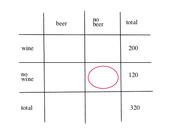
Now plug in the information from the first statement.
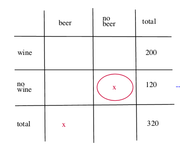
Even if we carry all of the information through and create relationships, we can't get to a value for x:
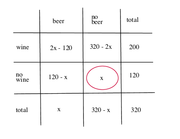
When we evaluate statement 2, we need to erase the information from statement 1 and consider it on its own:
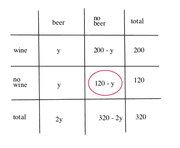
Again, we don't have enough information to get to a value for y, so we can't solve.
If we put the statements together, though, then we have enough information to solve for a value:
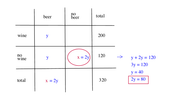
The answer is C.

Now plug in the information from the first statement.

Even if we carry all of the information through and create relationships, we can't get to a value for x:

When we evaluate statement 2, we need to erase the information from statement 1 and consider it on its own:

Again, we don't have enough information to get to a value for y, so we can't solve.
If we put the statements together, though, then we have enough information to solve for a value:

The answer is C.
Ceilidh Erickson
EdM in Mind, Brain, and Education
Harvard Graduate School of Education
EdM in Mind, Brain, and Education
Harvard Graduate School of Education
GMAT/MBA Expert
- ceilidh.erickson
- GMAT Instructor
- Posts: 2095
- Joined: Tue Dec 04, 2012 3:22 pm
- Thanked: 1443 times
- Followed by:247 members
For more on overlapping sets, see here: https://www.beatthegmat.com/survery-resu ... tml#576105
Ceilidh Erickson
EdM in Mind, Brain, and Education
Harvard Graduate School of Education
EdM in Mind, Brain, and Education
Harvard Graduate School of Education
-
GaneshMalkar
- Senior | Next Rank: 100 Posts
- Posts: 77
- Joined: Tue Jul 31, 2012 6:53 am
- Thanked: 8 times
- Followed by:1 members
Atekihcan wrote:Total (T) = Beer (B) + Wine (W) - Both (H) + None (N)
We need to determine N.
Now, T = 320 and W = 200
So, 320 = B + 200 - H + N
So, N = 320 - (B + 200 - H) = 120 - B + H
Statement 1: B = N
So, N = 120 - N + H
So, 2N = 120 + H
As we don't know H, we cannot determine N.
So, statement 1 is not sufficient.
Statement 2: Only beer = (B - H) = H
So, 2H = B
So, N = 120 - B + H
So, N = 120 - H
As we don't know H, we cannot determine N.
So, statement 2 is not sufficient.
Both statements together: 3N = 240
So, N = 80
So, both statements together is sufficient.
Answer : C
I may be wrong in my understanding but the Question says "drank wine". So the bold above W = 200 shouldn't be W + B = 200; Since drank wine I interpreted as "not only Wine".
If you cant explain it simply you dont understand it well enough!!!
- Genius
- Genius



















